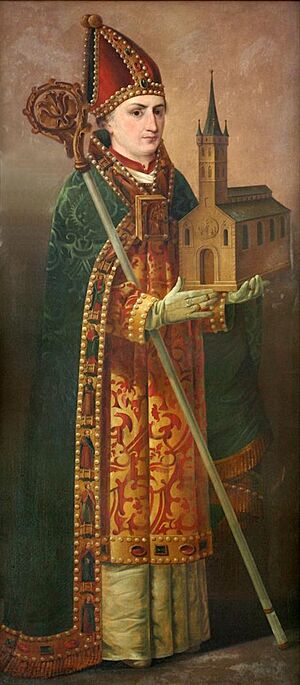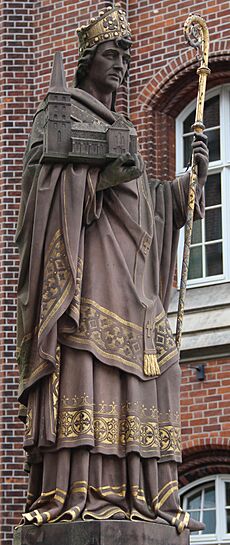Ansgar facts for kids
Quick facts for kids SaintAnsgar |
|
|---|---|

A depiction of Saint Ansgar by Siegfried Bendixen from the Church Trinitatis, in Hamburg, Germany
|
|
| Apostle of the North | |
| Born | 8 September 801 Corbie, Frankish Kingdom |
| Died | 3 February 865 (aged 63) Bremen, East Francia |
| Venerated in | Catholic Church Eastern Orthodox Church Anglican Communion Lutheranism |
| Feast | 3 February |
| Attributes | Dressed in archbishop's attire with a model of the church |
| Patronage | Scandinavia, Missionaries |
Saint Ansgar (born September 8, 801 – died February 3, 865) was an important church leader. He was the Archbishop of Hamburg-Bremen in a kingdom called the East Franks. People often called him the "Apostle of the North." This was because he traveled a lot to spread Christianity in Northern Europe. His church in Hamburg was given the special job of bringing the Christian faith to places like Denmark, Norway, and Sweden.
Contents
Early Life and Missions
Ansgar was born into a noble family near Amiens, which is in modern-day France. His mother died when he was young. He was then raised in a Benedictine monastery called Corbie Abbey.
A book about his life, called Vita Ansgarii, says that Ansgar had a vision. In this vision, he saw his mother with Mary, mother of Jesus. This experience made him take his spiritual life much more seriously. His student and future biographer, Rimbert, believed these visions were a big reason for Ansgar's life choices.
Ansgar's work was part of a larger effort to spread Christianity in Saxony (now northern Germany). This effort was started by Charlemagne and continued by his son, Louis the Pious.
In 822, Ansgar became a missionary. He helped found a new monastery called Corvey in Westphalia. There, he worked as a teacher and preacher.
Later, Ansgar and other monks went north to Jutland (part of Denmark). They went with King Harald Klak, who had recently become Christian. But in 827, King Harald lost his power. Ansgar's friend, Autbert, also died. Their school for royal children closed, and Ansgar returned to Germany.
In 829, the Swedish king, Björn at Hauge, asked for missionaries. King Louis sent Ansgar, along with another monk named Witmar. Ansgar preached and helped many people become Christian. He spent six months in Birka, a town on Lake Mälaren. A wealthy widow named Mor Frideborg welcomed him. Ansgar started a small church group there. Mor Frideborg and the king's steward, Hergeir, were important members.
Archbishop of Hamburg-Bremen
In 831, Ansgar returned to King Louis's court. He was then made the Archbishop of Hamburg-Bremen. This was a new and important position. It included the areas of Bremen and Verden. It also gave him the right to send missionaries to all the northern lands. He could also appoint new bishops for those areas.
Ansgar was given the special job of bringing Christianity to Denmark, Norway, and Sweden. The King of Sweden decided to use a special drawing of lots to see if Christian missionaries would be allowed in his kingdom. Ansgar prayed about it, and the lot was favorable.
Ansgar became a bishop in November 831, with the approval of Pope Gregory IV. He traveled to Rome to receive a special cloth called a pallium directly from the Pope. He was officially named the Pope's representative for the northern lands.
Ansgar then focused on his own church area, which was still new and had few churches. He started a monastery and a school in Hamburg. These were meant to help the mission in Denmark, but they didn't achieve much at first.
Challenges and Perseverance
In 840, King Louis the Pious died, and his empire was divided. Ansgar lost a monastery called Turholt, which King Louis had given him to support his work.
Then, in 845, Danes attacked Hamburg unexpectedly. They destroyed all the church's valuable items and books. Ansgar lost his church and his income, and many of his helpers left him. The new king, Louis the German, did not give Ansgar back the Turholt monastery.
However, in 847, Ansgar was named to lead the church area of Bremen, which was empty. He moved there in 848. But joining the churches of Bremen and Hamburg was difficult because Bremen had been under the Bishop of Cologne. After long talks, Pope Nicholas I finally approved the joining of the two church areas in 864.
Despite these problems, Ansgar kept working on his mission in the north. A civil war in Denmark forced him to build good relationships with two kings, Horik the Elder and his son, Horik II. Both kings helped him until his death. Ansgar was able to get permission to build a church in Sleswick (north of Hamburg). He also got Christianity recognized as a religion that people could practice freely.
Ansgar did not forget his mission in Sweden. He spent two years there (848–850) to prevent people from returning to pagan beliefs. In 854, Ansgar went back to Sweden when King Olof ruled in Birka. According to Rimbert, King Olof was open to Christianity.
Death and Legacy
Ansgar died in Bremen in 865. His student and the next archbishop, Rimbert, wrote a book about his life called Vita Ansgarii. Rimbert wrote that Ansgar wore a rough hair shirt, lived on bread and water, and was very kind to the poor.
Pope Nicholas I declared Ansgar a saint soon after he died. Ansgar was the first true missionary in Sweden and the Nordic countries. He also helped organize the Catholic Church there. Because of his work, he was later called the "Patron of Scandinavia".
Some of Ansgar's relics (holy items) are in Hamburg. You can find them in St. Mary's Cathedral and St. Ansgar's and St. Bernard's Church.
Statues of Saint Ansgar stand in Hamburg, Copenhagen, and Ribe. There is also a stone cross at Birka. His special day, or feast day, is February 3. This day is celebrated by the Church of England, the Episcopal Church, and the Evangelical Lutheran Church in America.
Visions
The book Vita Ansgarii ("The Life of Ansgar") was written by Rimbert. While it's a historical document, its main goal is to show how holy Ansgar was. The book talks a lot about Ansgar's visions. According to Rimbert, these visions encouraged and helped Ansgar in his amazing missionary work.
Throughout his life, Ansgar often started a new part of his journey after having a vision. For example, his early studies and his decision to live like a monk were inspired by a vision. In this vision, he saw his mother with Mary, mother of Jesus.
Another time, the Swedish people were without a priest for a while. Ansgar asked King Horik to help him solve this problem. After the king agreed, Ansgar talked with Bishop Gautbert to find a good person for the job. They both sought King Louis's approval, which he gave. Ansgar felt sure that heaven was telling him to go on this mission. He was influenced by a vision he had when he was worried about the journey. In this vision, he met a man who told him not to worry. The man also told him he would meet a prophet, the abbot Adalhard. This abbot would tell him what would happen next.
In the vision, Ansgar found Adalhard. Adalhard said, "Islands, listen to me, pay attention, remotest peoples." Ansgar understood this to mean that God wanted him to go to the Scandinavian countries. He thought this because "most of that country consisted of islands." Also, the words "I will make you the light of the nations so that my salvation may reach to the ends of the earth" were added. Ansgar believed the "end of the world in the north" was in Swedish territory.
See also
 In Spanish: Ascario de Amiens para niños
In Spanish: Ascario de Amiens para niños
- List of Eastern Orthodox saints
- Calendar of saints (Episcopal Church)
- Hochkirchlicher Apostolat St. Ansgar
- Priory of St. Ansgar
- Sankt-Ansgar-Schule
- Vita Ansgarii


